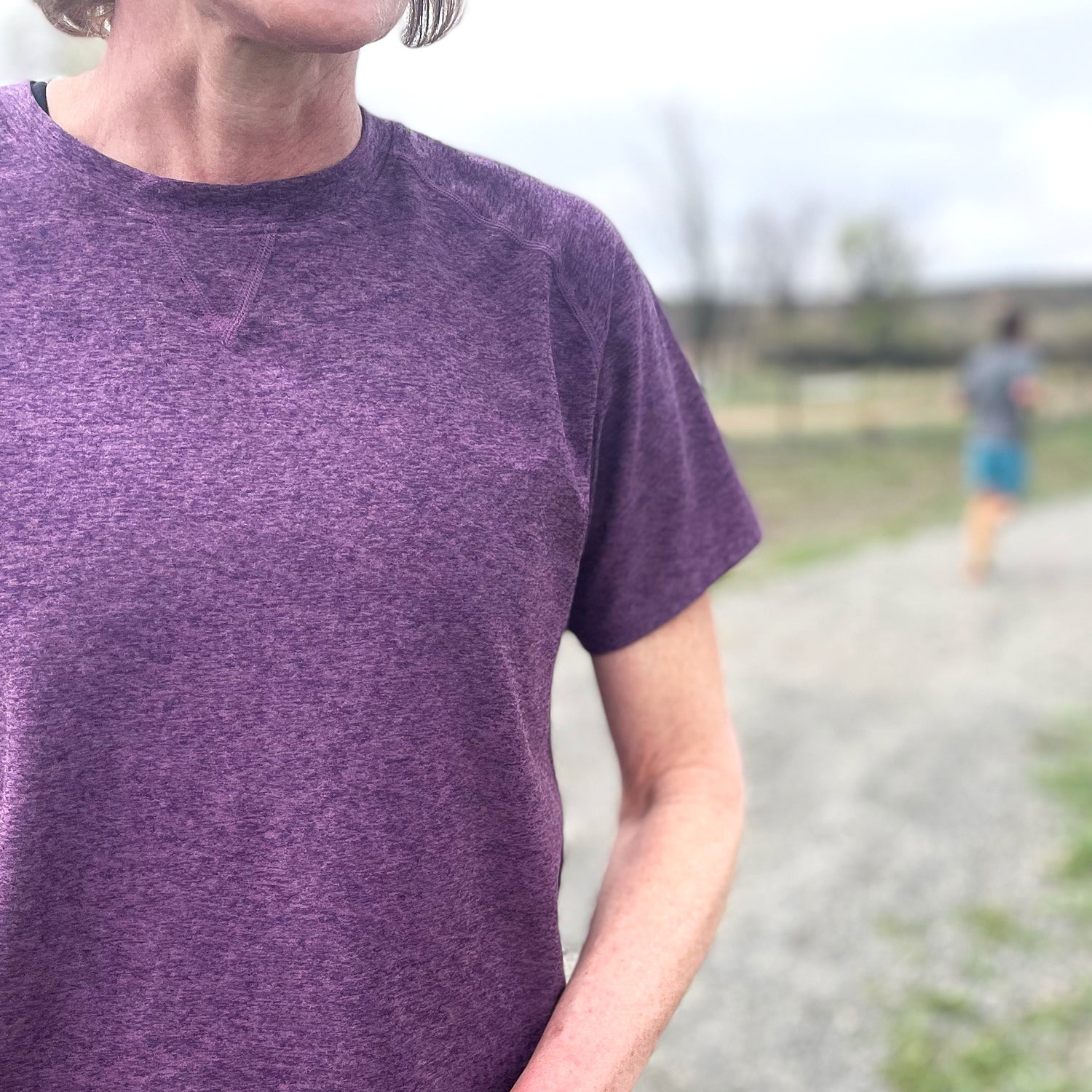The sun is shining, the birds are chirping. Summer’s longer days and warmer temperatures make for fun and free running. There’s just one problem: The heat can sap your running performance and enjoyment. Choosing the right apparel in summer—in the same way you bundle up in winter—can make the conditions not only bearable, but fun.
In this season, we need running shirts that slip on effortlessly when we’re still half-asleep in the morning, and float on our skin when we’re cramming in a tempo workout on a sticky afternoon. We searched for, and found, the best women’s running tops—t-shirts and tanks—that can handle the challenges of summer while making us look good and feel cool.
Update May 2025: We selected new running tops in all but one category, carrying over the perennially popular Tracksmith Session Tee. We also added objective lab measurements on air permeability and dry time to help you select the best summer running shirt for you. Be sure to check out the “How We Test” section below for more details on our methodologies and how to interpret the lab data.
At a Glance
- Best Tee for Hot Weather Running: Craft Pro Hypervent Running Tee 2.0 ($60)
- Best Tank for Hot Weather Running: Patagonia Capilene Cool Daily Tank ($39)
- Best Raceday Tank: Hoka Airolite Run Tank ($52)
- Most Versatile Tank: Brooks Luxe Tank ($45)
- Most Versatile Tee: Tracksmith Session Tee ($75)
- Best Value: 2XU Aero Singlet ($35)
- Best Trail Running Tank: Arc’Teryx Norvan Tank ($80)
- Best Trail Running Tee: Black Diamond Distance SS Tech Tee ($65)
- Softest Tank: Rabbit EZ Tank ($48)
- Softest Tee: Oiselle Flyout Boxy Short Sleeve ($62)
- What to Look For
- How We Tested Running Tops In the Field and the Outside Lab
- Meet Our Lead Testers

How We Tested Running Shirts In the Outside Lab
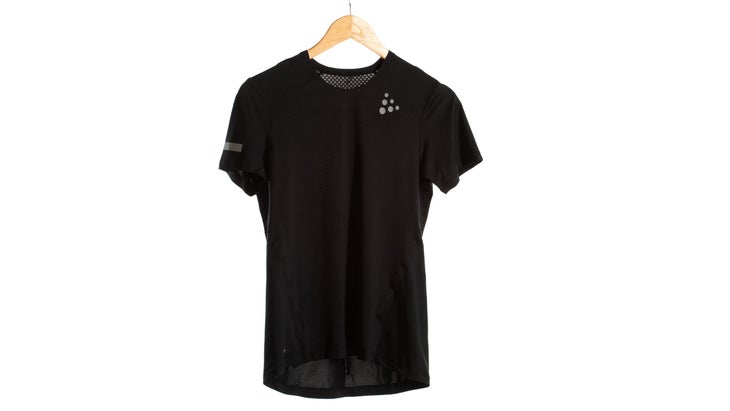
Best T-Shirt for Hot Weather
Craft Pro Hypervent Running Tee 2.0
$60 at Fleet Feet $60 at Craft
Sizes: XS-XL
Pros and Cons
⊕ Extremely lightweight
⊕ Seamless comfort
⊗ Shows sweat
Lab Dry Time: 3 (1=worst; 5=best)
Lab Air Permeability: 3 (1=worst; 5=best)
How We Tested Running Shirts In the Outside Lab
In summer heat, a shirt that feels barely there and still provides shoulder coverage is a Godsend, and the Craft Hypervent Tee 2.0 delivers. It’s made of a super-lightweight recycled polyester/elastane blend that isn’t the fastest drying or airiest but is silky smooth against the skin with a mesh back that breathes well while still shielding us from the sun. “It’s great for summer heat because it’s so lightweight—it flitters like an aspen leaf,” raved a tester.
Taped seams at the neck and sleeves are comfortable (no chafing) and add to the shirt’s feminine silhouette. The sleeves are cut longer than regular tees and add coverage, while the raglan design allows unrestricted arm movement. “No seams is a huge plus for me,” said a tester who also loved the lack of a papery tag rubbing the back of her neck. “This was a shirt I didn’t have to think about while running,” said another.
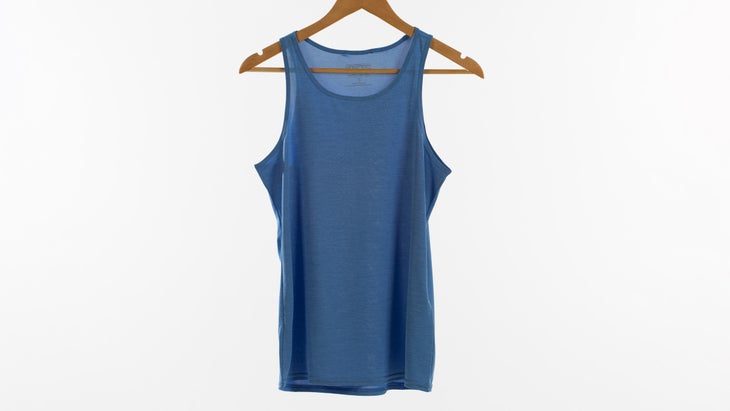
Best Tank for Hot Weather
Patagonia Capilene Cool Daily Tank
Sizes: XS-XL
Pros and Cons
⊕ Extremely lightweight
⊕ Minimal branding allows versatility
⊗ Runs large
Lab Dry Time: 4 (1=worst; 5=best)
Lab Air Permeability: 3 (1=worst; 5=best)
How We Tested Running Shirts In the Outside Lab
We loved the feel of this tank for everything from warm-weather runs in Colorado to high-humidity hikes in the Caribbean. Testers described the recycled polyester Capilene Cool fabric as “extremely lightweight” and said it helped them “maintain comfort while sweating.” The thin fabric dries quickly, a bonus in summer heat, whether on the run, during water sports like stand-up paddleboarding, or when traveling.
Like most Patagonia apparel, the fit of this tank runs a little large, but we liked the relaxed shape. It’s one tester’s go-to shirt while wearing compression-style bootie shorts. “I like the coverage of the longer cut,” she said. We also loved the versatility of the tank’s styling—the only visible branding is a tiny Patagonia tag at the bottom seam, so it doesn’t look overly athletic and out of place off the trail.
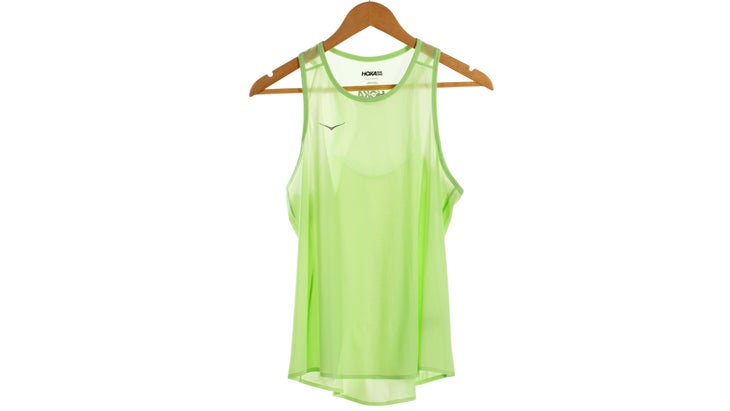
Best Raceday Tank
Hoka Airolite Run Tank
Sizes: XS-XXL
Pros and Cons
⊕ Airy fabric and cut
⊕ Fabric is rated 40+ UPF
⊕ Higher neckline provides coverage
⊗ Can creep up under a pack
Lab Dry Time: 2 (1=worst; 5=best)
Lab Air Permeability: 5 (1=worst; 5=best)
How We Tested Running Shirts In the Outside Lab
This tank is ready for race day with a highly breathable material and a slim fit that stays out of the way of an arm swing. We love the airy feel of the super lightweight pinhole mesh combined with an even-more-open mesh panel on the upper back–the whole tank breathes fantastically. It’s thin, super lightweight, and feels cool against the skin. “I definitely noticed it helped keep me feeling cooler and dry even when sweating heavily in higher temps,” said a tester. “It feels very performance-oriented,” said another. In the lab, it scored the highest mark for air permeability among all shirts tested. The fabric is so light that it crept up a bit while we tested it under a hydration vest, but it stays perfectly put on its own.
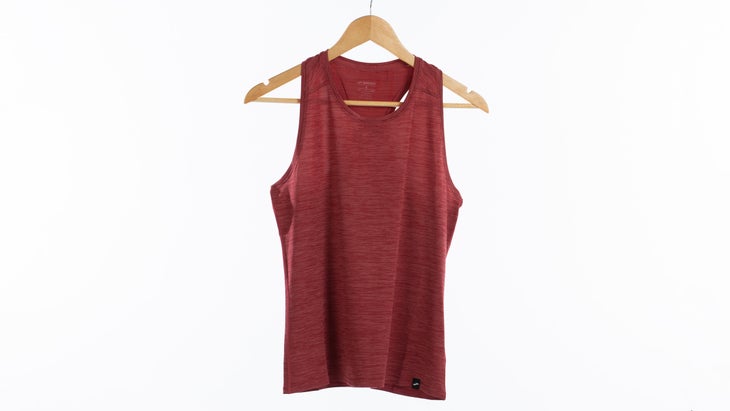
Most Versatile Tank
Brooks Luxe Tank
Sizes: XS-XXL
Pros and Cons
⊕ Super soft
⊕ Minimal branding
⊗ Underarm seams slightly rub (but not chafe)
Lab Dry Time: 3 (1=worst; 5=best)
Lab Air Permeability: 2 (1=worst; 5=best)
How We Tested Running Shirts In the Outside Lab
This soft, breathable, minimally branded tank looks so good we’ve worn it casually to run errands around town, but the stylishness doesn’t compromise how well it feels and moves on the run. The cut is slightly long and loose, which makes it comfortable, flattering, and adds to its versatile appeal—it can work both tucked in or left out. “So soft and breathable,” said a tester, while another marveled at how lightweight the material felt against her skin.
A couple testers noted the underarm cut was a tad high, making the non-flat seams rub their armpits, but it was more of an irritation than a run-ruining situation—no chafing. But that was easy to overlook given the tank’s versatility. “This tank is great to layer under a long sleeve for a morning run when it starts cool and will warm up,” said one tester. “I also love it for a short run, when it can double as a casual tank to run errands in before or after.”

Most Versatile Tee
Tracksmith Session Tee
Sizes: XS-XL
Pros and Cons
⊕ Versatile
⊕ Soft and Stretchy
⊗ Runs slightly large
Lab Dry Time: 1 (1=worst; 5=best)
Lab Air Permeability: 2 (1=worst; 5=best)
How We Tested Running Shirts In the Outside Lab
We’ve used this as a go-to running tee and an all-day tee—wearing it casually throughout the day then on an evening run. One tester even slept in it. Made of 84 percent polyester and 16 percent spandex, the Session Tee is exceptionally stretchy. It’s also finished with an odor-resistant treatment that seems to work: We’ve worn it for multiple runs without washing and swear that we’re not offending trail partners. (They concur.) The Session Tee dries slower and is less airy than other high-performance tops—so it isn’t the best choice for the hottest days—but makes up for that in soft comfort and style.
“I’m in love with everything about this shirt: the fit, the fabric, the performance,” said a tester. “It felt like a hang out shirt that I could run in!” another raved, “I forgot about this shirt during the run because it was so comfy and has the most perfect fit!”

Best Value
2XU Aero Singlet
Sizes: XXS-XL
Pros and Cons
⊕ Lightweight and breathable
⊕ Reflective detailing
⊗ Can feel loose around the midsection (this can also be a positive)
Lab Dry Time: 5 (1=worst; 5=best)
Lab Air Permeability: 3 (1=worst; 5=best)
How We Tested Running Shirts In the Outside Lab
It’s hard to find well-functioning running apparel under 40 bucks, but this tank delivers. Its lightweight, sweat-wicking front (a double-knit recycled polyester), combined with a super-breathable mesh back kept us cool for all our summer running. “This tank wicked sweat away, didn’t chafe, and was very comfortable in warmer temps,” said a tester.
The simple cut provides a bit more coverage on the backside than traditional racerback tanks, and has a looser fit around the middle. Some felt it to be too baggy at the waist and loose on the lower back while others liked the flowy feel. Reflective details add safety in dusk and dawn light.
“The lightweight fabric throughout seems inherently breathable,” said one who also praised how quickly sweat dried. “The fabric is slightly textured as opposed to just one single layer which seemed to encourage even more airflow, and it dried quickly,” said another. The lab confirmed the testers observations: this tank had the best combined performance scores of all the tops we tested.
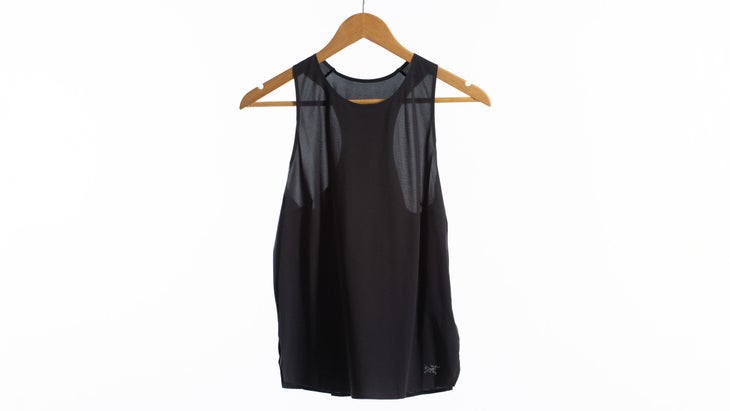
Best Trail Running Tank
Arc’teryx Norvan Tank
$80 at Arc’teryx $80 at Zappos
Sizes: XXS-XXL
Pros and Cons
⊕ Wide shoulder straps work well under a pack
⊕ Lightweight, airy, and quick-drying
⊗ 80 bucks is a lot for a tank
Lab Dry Time: 5 (1=worst; 5=best)
Lab Air Permeability: 2.5 (1=worst; 5=best)
How We Tested Running Shirts In the Outside Lab
Some tank shoulder straps can start to rub underneath a hydration vest or traditional running pack straps, but not the straps on this one. A wider cut at the shoulders stayed flat and in place under a pack during hours of mountain running in Colorado’s Indian Peak Wilderness.
This is a looser-fitting tank, which we loved for its forgiving fit all around and slightly longer cut. The material—a softer polyester frontside with a meshy backside—feels great against the skin, breathes well, and dries quickly (the fastest-drying of all the tops here, according to the lab). All seams remained comfortable over hours of wear as well—no chafing here.

Best Trail Running Tee
Black Diamond Distance SS Tech Tee
$65 at Backcountry $69 at Black Diamond
Sizes: XS-XL
Pros and Cons
⊕ Extremely lightweight, breathable, and quick drying
⊕ Zero irritation over long wear
⊗ Not as cottony feeling as some others
Lab Dry Time: 4 (1=worst; 5=best)
Lab Air Permeability: 3 (1=worst; 5=best)
How We Tested Running Shirts In the Outside Lab
We’ve worn this tee under a pack over multi-day runs from hut to hut in the White Mountains of New Hampshire, as well as on multiple short runs around the Boulder Foothills and neighborhood suburbs. This shirt performs: It’s super-quick-drying, moisture-wicking, highly breathable polyester jersey material with a “Quick Dry” finish that never feels bogged down with sweat. The Anti-Odor finish also proved effective—did we mention that multi-day, multi-wear hut trip? We got no complaints from our running mates. Flat lock seams, a flat hem, and lack of a tag add to overall comfort, as does this shirt’s ridiculously lightweight feel on the body.
“Loved the material. It’s loose, super ventilated and fits well throughout,” raved a tester. “Excellent performance,” said another.
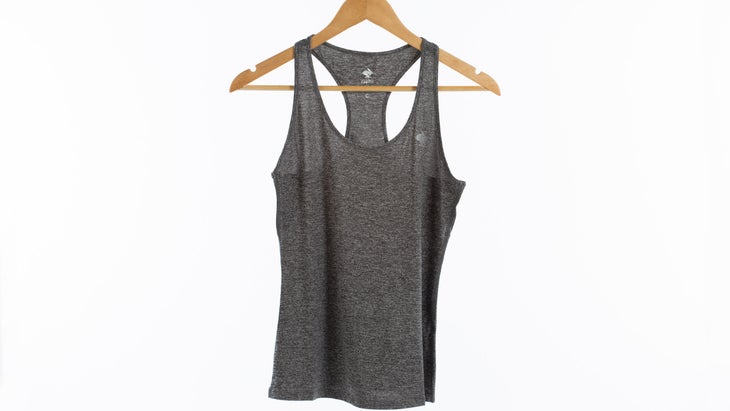
Softest Tank
Rabbit EZ Tank
$48 at REI $48 at Running Warehouse
Sizes: XXS-XXL
Pros and Cons
⊕ Super soft and comfortable
⊕ Bonded seams
⊗ Runs small (size up!)
Lab Dry Time: 4 (1=worst; 5=best)
Lab Air Permeability: 2 (1=worst; 5=best)
How We Tested Running Shirts In the Outside Lab
Talk about buttery soft. This tank is made from the brand’s recycled polyester/spandex blend that feels like your favorite old cotton t-shirt, softened in the wash after decades of use. But unlike cotton, this material dries quickly after being soaked in sweat. While the material might not be as breathable as some other techier-feeling tanks or tees in this roundup, it feels fantastic on the skin and still performs even when damp. “The softness and overall comfort made up for the lack of breathability,” said a tester. “It’s become one of my favorites. It’s just very ‘ez’ to wear.” We find ourselves reaching for this tank, and the Rabbit EZ Tee, for lounging; it’s that comfortable.
Bonded seams around the armholes and neckline remained soft and proved irritation-free for our team of testers.
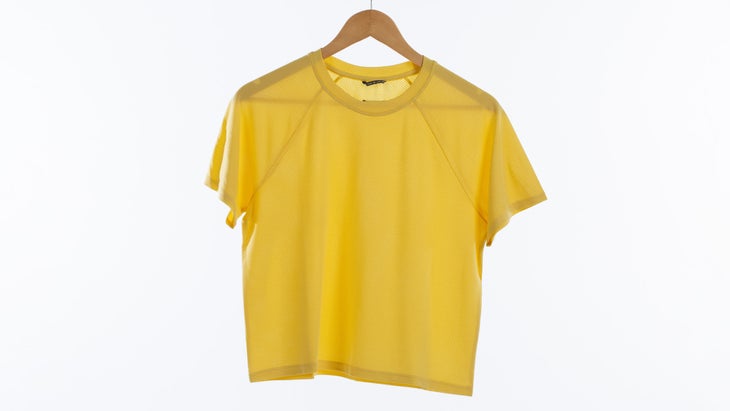
Softest Tee
Oiselle Flyout Boxy Short Sleeve
Sizes: 2-14
Pros and Cons
⊕ Great combo of style and function
⊕ Great range of sizing
⊗ Takes longer to dry than some
Lab Dry Time: 3 (1=worst; 5=best)
Lab Air Permeability: 4 (1=worst; 5=best)
How We Tested Running Shirts In the Outside Lab
This comfortable, functional tee converted more than one non-crop-top-wearing tester into big fans. The polyester/lyocell/spandex fabric felt fantastically soft next to the skin and kept us dry when we sweat—the fabric effectively moves moisture to the outer layer where it evaporates. (While the sweat doesn’t stay against the body, it does seem to remain on the shirt’s fabric for longer than some quick-dry materials.)
The boxy, crop-style cut adds airflow. We loved it when paired with high-rise thin tights on warm runs and appreciated the cut for gym workouts. “I liked how I could see my toes in a plank!” said one.
How To Choose a Running Top
When it comes to summer running clothes, look for comfort, breathability, moisture-wicking, and a chafe-free fit.
Comfort
Aside from chafe-free seams and a cut that allows full arm movement without restriction, consider how the tank or tee makes you feel. Are you comfortable wearing the top both on a run and stopping for coffee afterward? Are you looking for a tank that makes you feel fast on raceday? Do you want a tee that also makes you feel comfortable—both in function and style— in the gym?
Materials
Breathable, sweat-wicking materials are essential, as is how the material feels against your skin. While some fabric blends prioritize breathability and quick-drying, others provide a more cottony feel—the latter sometimes stay wet from sweat longer than the prior, but the tradeoff is sometimes worth it. All tops in this round up perform great on the run.
Fit
The fabric, cut, and seam placement should not restrict your arm movement or your breathing. The best-fitting tops let you forget that you’re wearing them. Some will fit looser or boxier around the middle, while some have a more streamlined fit. Consider what you’re after and shop from there. (Our guide describes the fit of each top.)
Tanks vs Tees
T-shirts provide more coverage and therefore more sun protection, and they can also deliver more of a cooling effect, depending on the fabric and fit. Tank tops are typically less restricting and more breathable, because of their lack of sleeves. That doesn’t mean all tank tops have freedom of movement. Some fit more streamlined around the midsection than others, while some are looser. The looser ones tend to allow airflow, while the more narrow silhouettes depend on their fabrication for breathability. In addition to fit, consider how much skin exposure and coverage you’re comfortable with, and how the tank interacts with your sports bra and running vest, if you’ll be wearing one. And consider all the settings where you’ll want to wear the top, both athletic and casual.

How We Test
- Number of testers: 8
- Number of products tested: 75
- Number of miles logged while testing: 2,500
We tested as many different shorts, tanks, tees, and other kinds of summer apparel (like sun shirts and crop tops) as we could get our hands on between June and October 2024, with an eye toward products that would be new to consumers in 2025. Our testers ranged in age from 20 to 40, each with more than a decade of running experience and at least one ultramarathon under their belt. We evaluated products by comfort first, followed by style, utility (ability to multitask as casual wear was a big plus), and durability. We also compared the new shirts to those test in the previous year and retained any that were still available and performed better than anything new in their categories.
How We Tested Running Shirts in the Outside Lab
Air Permeability
Air permeability is a measure of how much air (in volume) is able to move through a fabric. It is not the same as “breathability” which measures how moisture vapor (sweat) moves through a fabric. The more air permeable, the more the cooling breeze makes it through your shirt and reaches your skin directly. To test this in the Outside Lab @ CU Denver, we use a James Heal AirPro, a machine that uses a vacuum pump to pull air through fabric clamped between plates with a specific diameter opening to measure the flow rate at a pre-set pressure. The greater the volume of air getting through, the more air permeable. This lab test only evaluates the material itself, and can’t account for how the cut and design of a garment aids its airiness.
Dry Time
The lab tested drying time by soaking each shirt and then recording how long each needed to dry. Each shirt was weighed while dry, then soaked in tap water until all of the material had absorbed water. After soaking, they were hand wrung until all excess water stopped releasing from the fabric, leaving a fully saturated, but not soaked, shirt. The saturated shirts were weighed again to get the “wet” starting point and then put on a mannequin to dry. Weight was recorded every hour to start and then every 15 minutes as they approached dryness, stopping when the sample was within 4 percent of the original dry value. Allowing for 4 percent of weight gain (a few grams) takes into account any dirt particles that could be introduced from the tap water or environment, and small hemmed areas of the shirt that may hold a little moisture, even though the overwhelming majority of the shirt is dry.
We compiled the raw data into groups of similar values for each measure to obtain scores of 1 to 5, worst to best, relative to all the t-shirts and singlets tested.
Meet Our Lead Tester
Lisa Jhung writes, runs, and generally adventures from her homebase in Boulder, Colorado. Raised as a California beach kid, she also makes it back to the coast—any coast, but primarily the Pacific—as often as possible. She’s been testing gear for Outside for a couple of decades and co-manages the road and trail running shoe tests, and maanages the women’s running apparel, sports bras, and running hydration vest tests.


